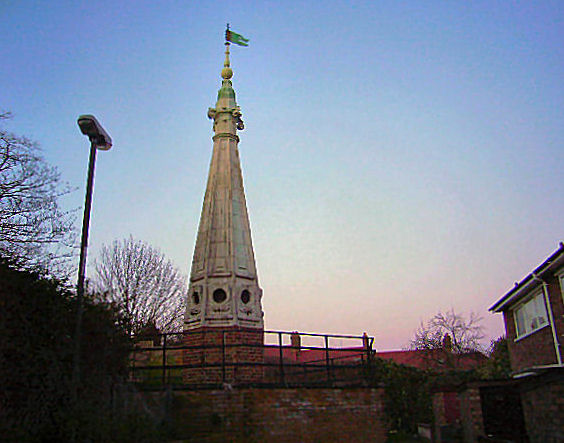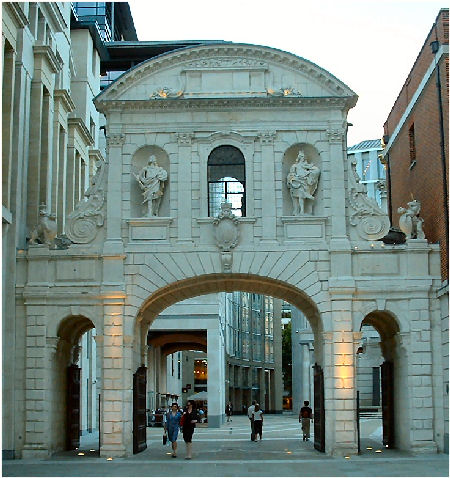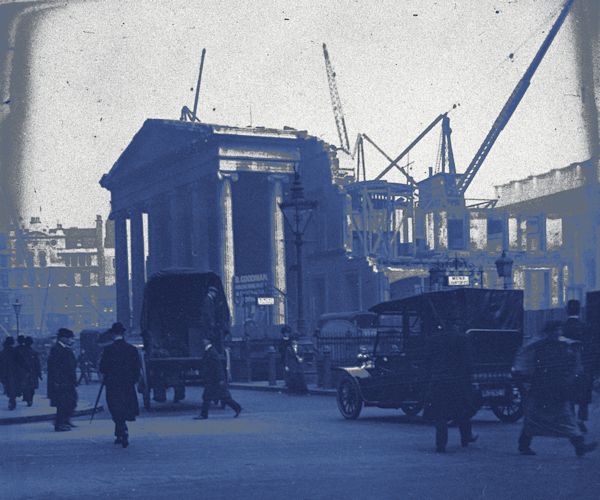Moving Objects: On the Move
"I may not have gone where I intended to go,
but I think I have ended up where I intended to be" Douglas Adams."

St Antholin's Spire.
In the leafy suburbs of Upper Sydenham is a very unusual and unexpected garden ornament consisting of the spire from one the Wrenís City of London churches, St Antholin. St Antholinís was originally dedicated to St Anthony, although from its very early years known as St Antholin's. The Church was rebuilt after the Great Fire of London 1666, by Sir Christopher Wren and completed in 1682. It bore a lofty spire and stood proudly in the City of London close to Budge Row and Sise Lane, opposite the Lord Mayor of Londonís Mansion House. St Antholinís was demolished during 1875, to make way for the construction of a new thoroughfare, Queen Victoria Street. The spire of this church was preserved and sold for five pounds. The buyer had it transported by horse and cart for its long final journey to his Sydenham residency, where it was soon re-erected in his rear garden at Round Hill House. Round Hill House has long since disappeared. However, this remarkable Wren spire still remains in the same spot where it has stood for over one hundred and forty years. Now the garden has made way to a small housing development. Unfortunately, there is no sign placed anywhere on the base of the spire to tell this story. Thus most of the local residents remain unaware of their historical curiosity.

The Black Bull.
This life-sized Black Bull has moved around quite a bit after first being modelled by Obadiah Pulham at Woodbridge in Suffolk, during the early 19th century. It was transported to London from the North Sea, by barge along the River Thames, to where it stood for nearly a century as the sign outside the ĎBlack Bull Inní on the corner of Leather-lane and Holborn, until the inn was demolished in 1904. The Black Bull was saved from destruction by Sir William Bull, M. P for Hammersmith. It was taken for its next journey across London to King Street Hammersmith, where it stood guard above the entrance to the offices of Messrs. Bull & Bull, a firm of solicitors until that building too was demolished. It was then taken for another journey just a few hundred yards along King Street, to adorn the front of the Ravenscourt Arms pub, where it has stood ever since - without causing too much attention.

Temple Bar.
Temple Bar was one of the gates through which people and traffic coming from the west had to pass before entering the City of London. It originally stood where Fleet Street now meets the Strand. The bar was first mentioned in 1293 when it stood outside the Temple law chambers being always associated with the "Bar." It is the only surviving gateway to the City and was removed and re-erected in Theobalds Park in Hertfordshire, where it remained neglected for many years. The Temple Bar was finally returned to the City of London, funded by the corporation of London to the tune of over three million pounds. The reconstruction of Temple Bar on an empty plot next to St Paul's Cathedral was completed in November 2004. There are four statues - Charles I, Charles II, James I and Anne of Denmark, which was carved by John Bushnell, which have now been restored in the main alcoves of Temple Bar. Now the only traffic that passes through the gateway is on foot.

General Letter Office, the headquarters for the General Post Office during demolition
Originally known as the General Letter Office, the headquarters for the General Post Office (GPO) was built on the eastern side of St. Martin's Le Grand in the City of London between 1825 and 1829, to designs by Robert Smirke.
The building's main facade had a central hexastyle Greek Ionic portico with pediment, and two tetrastyle porticoes without pediments at each end. The main interior was the large letter-carriers' room, with its elegant iron gallery and spiral staircase.
When the Central London Railway was constructed in 1900, a nearby station was named Post Office (now called St. Paul's). The original Smirke building was closed in 1910 and demolished in 1912.

The only fragment that survives is the Ionic capital from the right-hand side of the portico. It is one of the fluted columns which graced the look of the old Post Office building. This five-ton piece, owned Mr Frank Mortimer a stonemason was presented to Walthamstow Urban District Council in 1954 and has been sited in Vestry Road ever since.
London Time

Follow Us
The contents of this website are the property of knowledgeoflondon.com and therefore must not be reproduced without permission. Every effort is made to ensure the details contained on this website are correct, however, we cannot accept responsibility for errors and omissions.
© Copyright 2004 -
Contact Us | Advertise